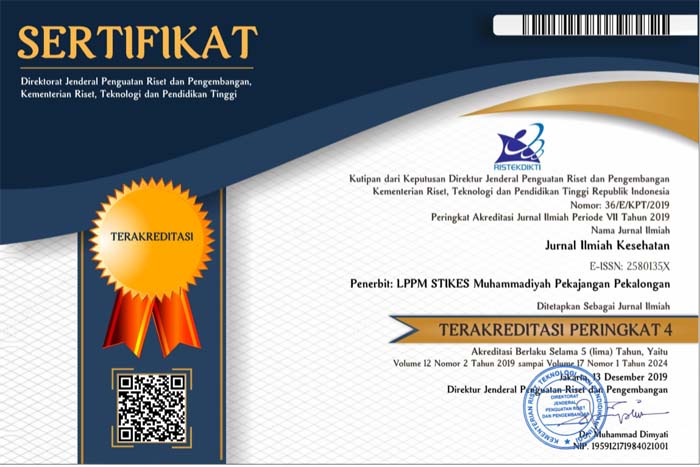Fitokimia dan Aktivitas Antioksidan Ekstrak Temu Blenyeh (Curcuma purpurascens Blumae)
DOI:
https://doi.org/10.48144/jiks.v15i1.627Keywords:
Uji fitokimia; antioksidan; ekstrak temu blenyeh; DPPHAbstract
Temu blenyeh (Curcuma purpurascens Bl) is a species of curcuma that is still rarely studied. Temu blenyeh is thought to have antioxidant activity so that it can reduce free radical activity. The purpose of this study was to screen phytochemicals and to determine the antioxidant activity of temu blenyeh extract using the 2,2-Diphenyl-2-picrylhydrazyl (DPPH) method. Temu blenyeh extract was macerated with 96% ethanol solvent, then its antioxidant activity was tested using the 2,2-Diphenyl-2-picrylhydrazyl (DPPH) method at a maximum wavelength of 515.8 nm and using vitamin C as a comparison. group of flavonoid compounds, alkaloids, tannins, saponins, triterpenoids and steroids. While the results of the antioxidant activity of temu blenyeh extract are in the very weak category with an IC50 of 458,888ppm and vitamin C with an IC50 of 3,294 ppm.
References
Oxford University Press, 2000.
M. Suhaj, “Spice antioxidant isolation and their antiradikal activity: A review.,” J. Food Compos. Anal., vol. 19, no. 6–7, pp. 531–537, 2006.
K. N. Babu, K. N. Shiva, M. Sabu, M. Divakaran, and N. Ravindran, “‘Turmeric,’ in Genetic Resources, Chromosome Engineering, and Crop Improvement,” Med. Plants, vol. 6, pp. 451–511, 2011.
S. L. Hong et al., “Essential oil content of the rhizome of curcuma purpurascens Bl. (Temu Tis) and its antiproliferative effect on selected human carcinoma cell lines,” Sci. World J., vol. 2014, 2014, doi: 10.1155/2014/397430.
E. Rouhollahi et al., “Curcuma purpurascens BI. rhizome accelerates rat excisional wound healing: Involvement of Hsp70/Bax proteins, antioxidant defense, and angiogenesis activity,” Drug Des. Devel. Ther., vol. 9, pp. 5805–5813, 2015, doi: 10.2147/DDDT.S88196.
S. Z. Moghadamtousi, M. N. A. Kamarudin, C. K. Chan, B. H. Goh, and H. A. Kadir, “Phytochemistry and biology of loranthus parasiticus merr, a commonly used herbal medicine,” Am. J. Chin. Med., vol. 42, no. 1, pp. 23–35, 2014, doi: 10.1142/S0192415X14500025.
F. Hajiaghaalipour, M. S. Kanthimathi, M. A. Abdulla, and J. Sanusi, “The Effect of Camellia sinensis on Wound Healing Potential in an Animal Model,” vol. 2013, 2013.
E. Rouhollahi et al., “Evaluation of acute toxicity and gastroprotective activity of curcuma purpurascens BI. rhizome against ethanol-induced gastric mucosal injury in rats,” BMC Complement. Altern. Med., 2014, doi: 10.1186/1472-6882-14-378.
E. Koller, Javanese medicinal plants used in rural communities. Universität Wien, 2009.
A. R. Wahid and S. Safwan, “Skrining Fitokimia Senyawa Metabolit Sekunder Terhadap Ekstrak Tanaman Ranting Patah Tulang (Euphorbia tirucalli L.),” Lumbung Farm. J. Ilmu Kefarmasian, vol. 1, no. 1, p. 24, 2020, doi: 10.31764/lf.v1i1.1208.
N. M. P. Susanti, I. N. . Budiman, and N. K. Warditiani, “Skrining Fitokimia Ektrak Etanol 90 % Daun Katuk ( Sauropus androgynus ( L .) Merr .),” Repos. Univ. Udayana, pp. 83–86, 2015.
Haniah, “Uji Aktivitas Ekstrak Metanol Daun Bunga Matahari (Hellianthus Annus L) sebagai Antimalaria pada Mencit.,” UIN Maulana Malik Ibrahim Malang, 2013.
F. Sakinah, “Uji Aktivitas Antioksidan Kombinasi Ekstrak Rimpang Kunyit Putih (Curcuma longa L.) Dan Rumput Bambu (Lophatherum gracile B.) Menggunakan Metode DPPH Serta Identifikasi Golongan Senyawa Aktifnya,” 2017.
V. Handayani, A. R. Ahmad, and M. Sudir, “Antioxidant Activity Test of Patikala Flower and Leaf Methanol Extract (Etlingera elatior (Jack) R.M.Sm) Using DPPH Method,” Pharm. Sci. Res., vol. 1, no. 2, pp. 86–93, 2014.
P. L. Lantah, L. A. Montolalu, and A. R. Reo, “Kandungan Fitokimia dan Aktivitas Antioksidan Ekstrak Metanol Rumput Laut Kappaphycus alvarezii,” Media Teknol. Has. Perikan., vol. 5, no. 3, p. 73, 2017, doi: 10.35800/mthp.5.3.2017.16785.
N. Fairuzi, Hamidah, and H. Purnobasuki, “Analisis Hubungan Kekerabatan Curcuma spp. Berdasarkan Karakteristik Morfologi dan Metabolit Sekunder,” J. Chem. Inf. Model., vol. 53, no. 9, pp. 1689–1699, 2019.
E. Sinaga, Suprihatin, and M. R. Rastuti, “Kadar Flavonoid Total, Daya Antioksidan dan Daya Hepatoprotektif Ekstrak Etanol Rimpang Temu Tis (Curcuma purpurascens),” in Konggres XX dan Pertemuan Ilmiah Tahunan Ikatan Apoteker Indonesia 2018, 2018, p. 13, [Online]. Available: http://repository.unas.ac.id/1570/1/B20-Prosiding-PIT-2018.pdf.
M. Marianne, P. Patilaya, and B. T. Barus, “Uji Aktivitas Antioksidan Kombinasi Ekstrak Etanol Rimpang Temu Giring (Curcuma Heyneana) dan Daun Pugun Tanoh (Curanga Fel-Terrae) Menggunakan Metode Diphenyl Picrylhydrazil(DPPH),” Talent. Conf. Ser. Trop. Med., vol. 1, no. 2, pp. 398–404, 2018, doi: 10.32734/tm.v1i2.223.
B. Setha, F. F. Gaspersz, A. P. S. Idris, S. Rahman, and M. N. Mailoa, “Potential Of Seaweed Padina Sp. As A Source Of Antioxidant,” Int. J. Sci. Technol. Res., vol. 2, no. 6, pp. 221–224, 2013.
I. Widyastuti, H. Z. Luthfah, Y. I. Hartono, R. Islamadina, A. T. Can, and A. Rohman, “Antioxidant Activity of Temulawak (Curcuma xanthorrhiza Roxb.) and its Classification with Chemometrics,” Indones. J. Chemom. Pharm. Anal., vol. 02, no. 1, p. 29, 2020, doi: 10.22146/ijcpa.507.
E. Septiana and P. Simanjuntak, “Aktivitas Antimikroba dan Antoksidan Ekstrak Beberapa Bagian Tanaman Kunyit (Curcuma longa),” Fitofarmaka, vol. 5, no. 1, pp. 31–40, 2015, [Online]. Available: http://ci.nii.ac.jp/naid/120005619654/.












